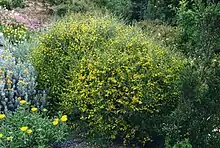Anthyllis hermanniae
Anthyllis hermanniae, called the lavender-leaved anthyllis, is a species of flowering plant in the family Fabaceae. It is found in Anatolia, Greece, the Balkans, and many Mediterranean islands, including Corsica.[2][3] Coleophora hermanniella, a species of moth found only on Corsica, feeds exclusively on A. hermanniae. A low perennial shrub, it is cultivated as a garden plant, and was formerly cultivated as far north as the United Kingdom, until the great frost of 1739 wiped them out there.[4]
| Anthyllis hermanniae | |
|---|---|
 | |
| Scientific classification | |
| Kingdom: | Plantae |
| Clade: | Tracheophytes |
| Clade: | Angiosperms |
| Clade: | Eudicots |
| Clade: | Rosids |
| Order: | Fabales |
| Family: | Fabaceae |
| Subfamily: | Faboideae |
| Genus: | Anthyllis |
| Species: | A. hermanniae |
| Binomial name | |
| Anthyllis hermanniae | |
| Synonyms[2] | |
|
List
| |
A. hermanniae is typically 1.5–2 feet tall, with crooked or zig-zag branches.[5] The leaves are simple or trifoliate, with soft silky hairs (more on the underside than the top).[6] This plant grows in a variety of habitats, but requires good drainage, often growing in rocky locations. It produces yellow flowers in late spring-early summer.[7]

Subspecies
Currently accepted subspecies are:[2]
- Anthyllis hermanniae subsp. brutia Brullo & Giusso
- Anthyllis hermanniae subsp. corsica Brullo & Giusso
- Anthyllis hermanniae subsp. ichnusae Brullo & Giusso
- Anthyllis hermanniae subsp. japygica Brullo & Giusso
- Anthyllis hermanniae subsp. melitensis Brullo & Giusso
- Anthyllis hermanniae subsp. sicula Brullo & Giusso
References
- Sp. Pl.: 720 (1753)
- "Anthyllis hermanniae L." Plants of the World Online. Board of Trustees of the Royal Botanic Gardens, Kew. 2017. Retrieved 7 July 2020.
- GBIF Backbone Taxonomy. "Anthyllis hermanniae L." gbif.org. GBIF Secretariat. Retrieved 7 July 2020.
- Wilkes, John (1810). Encyclopaedia Londinensis, or, Universal Dictionary of Arts, Sciences, and Literature: Comprehending, Under One General Alphabetical Arrangement, All the Words and Substance of Every Kind of Dictionary Extant in the English Language: In Which the Improved Departments of the Mechanical Arts, the Liberal Sciences, the Higher Mathematics, and the Several Branches of Polite Literature, Are Selected from the Acts, Memoirs, and Transactions, of the Most Eminent Literary Societies, in Europe, Asia, and America: Forming a Comprehensive View of the Rise, Progress, and Present State, of Human Learning in Every Part of the World: Embellished by a Most Magnificent Set of Copper-Plate Engravings. Vol. 1. London: J. Adlard. p. 762.
- "Anthyllis hermanniae - Trees and Shrubs Online". treesandshrubsonline.org. Retrieved 2021-06-11.
- Mifsud, Stephen (2002-08-23). "Anthyllis hermanniae subsp. melitensis (Maltese Yellow Kidney Vetch) : MaltaWildPlants.com - the online Flora of the Maltese Islands". www.maltawildplants.com. Retrieved 2021-06-11.
- "Anthyllis hermanniae". www.wildflowersofskopelos.org.uk. Retrieved 2021-06-11.